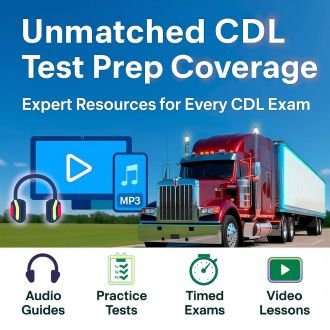There are several steps in the process of getting a CDL, or commercial driver’s license. If you want more information about what a CDL is and the types of CDLs there are, get a refresher here. Also get up to speed about the Federal and State CDL requirements here.
In many states you must successfully complete a training course at an approved CDL truck driver training school before you can get a CDL. The days of getting trained by your uncle Albert and getting your CDL may be coming to an end. Many trucking companies will also require this, so take this into consideration when deciding between methods of training. Getting a CDL is an essential step, but if you can’t get a good truck driving job it hardly matters.
Steps Involved in Getting Your CDL
1. Meet the CDL requirements.
First, make sure you meet minimum Federal CDL requirements as well as a directory to the CDL requirements in your state.
2. Get your state CDL manual.
Your state CDL manual is the basis for all your official state written CDL exams. In addition, the manual has specific information for your state such as age and medical requirements, as well as testing locations and fees.
If you already know what type of CDL you need, proceed to step 4.
3. Decide which types of CMVs you want to drive.
To proceed, you need to know your options. This will help you determine which tests you need to take to get your CLP (Commercial Driver’s License Learner’s Permit) in Step 4 below.
At the very minimum, you’ll need to study the first 3 sections of your CDL manual to prepare to pass the General Knowledge exam. Take General Knowledge practice tests here.
You’ll also need to pass the Air Brakes exam. Otherwise, you’ll have an air brakes restriction on your CDL leaving you unable to drive a CMV with air brakes. Take Air Brakes practice tests here.
If you’re planning on driving a tractor trailer of any kind, you’ll have to pass the Combination Vehicles exam. Take Combination Vehicles practice tests here.
For more information on the different CDL endorsements there are, plus advice on which ones you should get, click here.
A CLP authorizes the operation of any vehicle (except a motorcycle or a vehicle carrying hazardous materials), when accompanied by a person who:
- Is 21 years of age or more
- Has a valid CDL for the class of vehicle being driven by the permit holder
- Has the proper endorsements for the type of vehicle being operated and
- Is sitting in the front seat next to the CLP holder.
To get a CLP, you’ll need to pass the test for the type of vehicle that you plan to operate. Check out this chart:
| Type of Vehicle | Test Required |
|---|---|
| All commercial vehicles | General Knowledge test |
| Any CMV with Air Brakes | Air Brakes test |
| Combination Vehicles | Combination Vehicles test |
| CMV with Hazardous Materials | Hazardous Materials test |
| CMV with Bulk Liquids or Gases | Tank Vehicles test |
| CMV with Double or Triple Trailers | Doubles and Triples test |
| School Bus | School bus endorsement test and passenger transport test |
| Other Bus | Passenger transport test |
Go back to Step 3 above for more info about how to determine which tests you’ll need to take to get your CLP.
4. Take and Pass your state CDL exams.
Once again, to be able to train in and drive most truck driving school’s vehicles, you’ll need to pass the General Knowledge, Air Brakes, and Combination Vehicles tests. You may need to pass additional endorsement tests, depending on the school. For example, if it’s a truck driving company sponsored school where that company hauls doubles/triples, or tankers, you’ll need to pass those tests as well.
In most states, the issued CLP is only valid for a limited period of time, often 180 days.
A CLP holder cannot operate a vehicle carrying hazardous materials. Also, obtaining a hazardous materials endorsement involves more than just passing the Hazmat written exam. See about the requirements and procedure involved in this process.
5. Obtain CDL Permit General Guidelines (For exact information for YOUR state, go to Trucker Country’s state CDL requirements directory here.)
- Be at least 18 years of age.
- Hold a valid driver license.
- Pass the knowledge tests for the type of vehicle you will be driving.
- Have a valid federal medical card. Persons who do not have a valid federal medical card will be restricted to:
- No CMV operation in interstate commerce.
- No CMV operation in intrastate commerce unless exempted by federal or state law (for example, employed by a governmental agency or operating a school bus). A state medical form is required for school bus operation.
Additional information regarding CLPs with Endorsements.
Even with your endorsements, as a CLP holder, you cannot do the following things until you’ve actually acquired your CDL. Read more information about this from the FMCSA.
- P (passenger endorsement): Cannot operate a CMV carrying passengers
- S (school bus endorsement): Cannot operate a school bus with passengers/students
- N (tank vehicles endorsement): Can only operate an empty tank vehicle.


